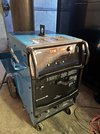I'm sure you meant 3/32" rod and not 3/16" but for the most part for your first time, those look pretty decent. Nothing to be ashamed of there at all.
If I could just give two bits of advice that are easy mistakes yet can turn into bad habits if not corrected right away.
First off, a few of your starts look a bit cold upon starting to add filler. I suggest practicing on starting a molten puddle, then hold that molten puddle and taper off. Then go ahead and start up again and get to the same size. Then practice running a puddle and controlling it before adding filler material. This little practice step will really help in puddle control and starting the puddle. You want to focus on getting that puddle molten and liquid well before adding filler or you will end up with a slightly cold beginning of the weld.
Secondly, upon ending a weld, I notice a few craters. Aluminum is especially susceptible to craters but practice on tapering off gradually and less abruptly to avoid craters at the end of the welds.
Mike
3/16" aluminum plate (parent material).
I used 2 different thicknesses of filler rod (1/8" & 1/16").
Thanks for the advice Mike, I'll definitely try all that. It's definitely different to start a puddle on aluminum because it doesn't change shape and color quite like mild steel. And it seems like a fine line between a puddle and overheating
I've been trying both starting my puddle at at the same angle as I push the puddle and totally verticle.
Is one a better practice than the other?
This was all with an on/off finger switch. I'll practice with the foot pedal next. I suppose I could increase the post flow to keep the puddle shielded better at the end or draw the tungsten back a bit too.
sorry to high jack this but you brought it up
i need a new helmet
what do you have?
Funny you should ask Rick.
I actually test drove the new Esab sentinel helmet and the Miller digital elite and believe it or not for the money (sub $300 range that I was shopping) the Arcsafe helmet by Vulcan was the best one for me (not to mention half the price).
The straps are excellent, the viewing area is very large and (in my opinion better positioned than the Miller) and a big deal for me: it sits very close to my face. I find myself sticking my head in tight spots a lot when I'm welding cages. I like the 4 independent arc sensors [(so if one is covered- say from a cage bar- it still darkens. (All of these have that feature)] Additionally: this may not be a big deal... but I like how the glass is flush with the rest of the helmet so junk like grinding dust and sparks doesn't seem to pile up on that "shelf." (The ESAB is similarly designed).
I'm not always the biggest fan of stuff at HF but it appears that they've got their act together with some of the premium brands they've recent brought in. It would seen they're private labeled for them but manufactured by someone else.
Time will tell if it lasts. I'm kinda hard on stuff. But my last helmet worked well for 7 years before it started flashing me and it was just a bargain auto darkening rig.


